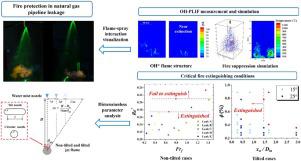Process Safety and Environmental Protection ( IF 6.9 ) Pub Date : 2021-02-24 , DOI: 10.1016/j.psep.2021.02.028 Yangpeng Liu , Jiaxing Shen , Jing Ma , Guochun Li , Zihao Zhao , Xiaomin Ni , Xishi Wang

|
Fire incidents caused by leaks from natural gas pipelines should be quickly controlled by using clean and efficient approaches, such as water mist. Previous studies on the methane-air jet fire suppression by water mist have paid not only little attention to the OH radical distribution characterizing the combustion intensity, but also critical extinguishing conditions of jet fires. Therefore, planar laser-induced fluorescence of the OH radical is obtained to visualize OH radical distribution in fire suppression. Fire Dynamics Simulator v 6.7.4 is applied to simulate the flame-spray interaction and detail the instantaneous fire-extinguishing process by the flow field, gas temperature, reaction methane mass fraction and radiation attenuation in non-lift-off jet flame scenarios. The results show that, considering variation of the jet flame tilt angle, the jet fires can be effectively suppressed when the gas-spray momentum ratio is below 0.0068 in non-tilted cases and normalized Reynold number is less than 2.56 in tilted cases. In the terms of water mist system optimization, the installation location of 1.45 times the pipe diameter was considered as the maximum nozzle horizontal position for fire suppression in the flame Froude number range of 0.2∼1.5. Besides, the OH-PLIF measurement revealed that fire suppression resulting from the kinetics effect depends on whether the OH* flame structure is quickly broken by the downward spray thrust. This study may provide suggestions for natural gas fire suppression with water mist system, and give help for the reduction of greenhouse gas emissions under Paris Agreement.
中文翻译:

水雾抑制甲烷-空气射流火焰的激光测量和数值模拟
天然气管道泄漏引起的火灾事故应通过使用清洁有效的方法(例如水雾)来迅速控制。先前对水雾抑制甲烷-空气喷射火的研究不仅很少关注表征燃烧强度的OH自由基分布,而且很少关注喷射火的灭火条件。因此,获得了OH自由基的平面激光诱导的荧光以可视化灭火中的OH自由基的分布。Fire Dynamics Simulator v 6.7.4用于模拟火焰-喷雾相互作用,并通过非升空喷射火焰情况下的流场,气体温度,反应甲烷质量分数和辐射衰减来详细说明瞬时灭火过程。结果表明,考虑到喷射火焰倾斜角的变化,在非倾斜情况下,当气体喷雾动量比低于0.0068且在倾斜情况下,归一化雷诺数小于2.56时,可以有效地抑制喷射火焰。就水雾系统的优化而言,在火焰弗劳德数范围为0.2至1.5的范围内,将安装位置的1.45倍管道直径视为灭火的最大喷嘴水平位置。此外,OH-PLIF测量表明,动力学效应产生的灭火效果取决于OH *火焰结构是否被向下的喷射推力迅速破坏。该研究可为采用水雾系统的天然气灭火提供建议,并有助于减少《巴黎协定》下的温室气体排放。











































 京公网安备 11010802027423号
京公网安备 11010802027423号